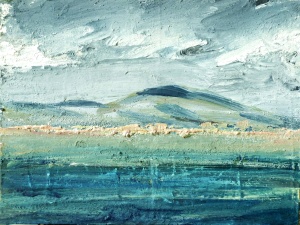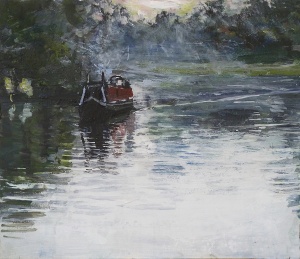Paintings from my Gloucestershire landscape series will be on exhibition at the Limetree Gallery in Bristol in the next month or so, they’re being framed there at the moment so I’ll update on that soon. (The series can be viewed from ‘Gallery’ in the menu above).
In the meantime, the next month will be taken up by house-related things and I’ll have no time to paint until mid-May when I’ll be staying for a while on Harris in the Outer Hebrides. So in the meantime I’m keeping my imagination fired up with some inspirational landscape-related books …
 At the moment I’m reading To the River by the wonderful author Olivia Laing, in which she explores the landscape and literature of Sussex near Lewes, including the many authors who lived or worked there, in particular Virginia Woolf.
At the moment I’m reading To the River by the wonderful author Olivia Laing, in which she explores the landscape and literature of Sussex near Lewes, including the many authors who lived or worked there, in particular Virginia Woolf.
Though most of my work is inspired by Scottish landscape, I also have an affinity with parts of the English landscape too, particularly the South Downs where my grandfather was born in a village called Stanmer near Lewes.
After art college, I lived in Brighton for a while in the 90s and walked across the entire length of the Downs bit-by-bit each weekend. I remember when I first arrived in Sussex I barely noticed the hills until I explored them, they looked small to my mountain-attuned eyes! But with familiarity I began to love the landscape – its plants, contours and the tangible sense of history in the formed and re-formed landscape, described so atmospherically in Laing’s To the River.
Her more recent novel The Lonely City was voted ‘Book of the year’ by the Observer, Guardian, Telegraph, New Statesman and Times Literary Supplement. I read it a couple of months ago and found myself mesmerised by her prose. I wouldn’t describe it simply as poetic or descriptive, it’s imaginative, philosophical, intimate, at times revelatory, also brilliantly researche d.
d.
To the River is equally evocative, transporting me back to the dreamlike landscape I experienced in this part of England in June. (I’ve included here some of my photos from the time, and excerpts from Laing’s book). The landscape feels utterly different from anywhere in Scotland; deep chalk beds, created by the remains of creatures from an ancient sea, form rolling turf-covered hills that were once covered in ancient forest.
 This ancient seabed originally formed a dome from the south coast to the Thames, which was worn away by rain and rivers to form the Weald (from the ancient German word ‘Wold’ meaning forest most likely) between the south and north downs – the remains of the original chalk dome.
This ancient seabed originally formed a dome from the south coast to the Thames, which was worn away by rain and rivers to form the Weald (from the ancient German word ‘Wold’ meaning forest most likely) between the south and north downs – the remains of the original chalk dome.
![]() Walking for miles over the downs in summer feels almost like a desert at mid-day. It’s the blinding sun, bouncing off white chalk and short turfy grass that makes clambering down the scarp slope (the chalky steep hillsides that form the edge of the downs) into the weald such a contrast. There’s a feeling of being immersed in damp, dense green foliage, also the scent of mud and river-beds. It feels somehow secretive or mysterious after the exposure of sun-baked hills.
Walking for miles over the downs in summer feels almost like a desert at mid-day. It’s the blinding sun, bouncing off white chalk and short turfy grass that makes clambering down the scarp slope (the chalky steep hillsides that form the edge of the downs) into the weald such a contrast. There’s a feeling of being immersed in damp, dense green foliage, also the scent of mud and river-beds. It feels somehow secretive or mysterious after the exposure of sun-baked hills.
Water seeps through the downs – about 500 meters of chalk – to emerge at the foot of the scarp slope at the edge of the weald where it forms streams then rivers. When you discover the source of one of these streams through a tangle of bushes the water is freezing, also pure (though that’s because it’s taken maybe decades to filter through and it’s water from the past, new farming methods might change the water purity in years to come).
I have distinct memories too of discovering the many small ancient churches often built close to Yew trees (probably to negate the earlier pagan use of these sites!) the scent of damp stone, incense, ancient wood and the coolness of thick-walled interiors after the heat outside.
Sometimes you might see the remains of a wall painting dating back to Norman times; a reminder of past times when England was in upheaval, and faced a change of rule, as it does again today.
Which brings me to politics! This is a personal art blog, but just as art is central to my life so is politics – not least the expression of individual cultures, or protection of landscape and environment. Here in Scotland it’s increasingly likely we’ll take a different path towards independence which I welcome wholeheartedly, but I feel for those in England, Wales and Northern Ireland who face change they didn’t vote for. Also for many leave voters the Brexit process appears to have been hijacked towards an austere agenda that threatens to undermine devolution across the UK as a whole.
Each part of the British Isles is wonderfully unique with its own shared experience, culture and expression. I hope people across the UK are ready to defend their right to autonomy, because there’s no doubt in my mind that the UK’s constitution and values are going to be altered to suit the current Tory agenda. This country must seem to some outsiders to be increasingly intolerant, undemocratic, unwelcoming, uncaring towards its own people, and especially towards people who are vulnerable through illness or misfortune. Still, we’re not in Trump-land, as yet! And nothing can alter the fact this is a country of beautiful, inspiring landscape, art, music, literature and imagination, incredibly varied for a small country.
The landscape of Sussex is linked in my imagination to Vaughan Williams (though he was born in Gloucestershire) probably because the first time I heard a live performance of The Sea Symphony was in Arundel cathedral. To me nothing evokes the green, mysterious atmosphere of the weald so expressively as William’s Fantasia on a Theme by Thomas Tallis (except perhaps Laing’s To the River) so I’ll end this meandering post on that note …





















































